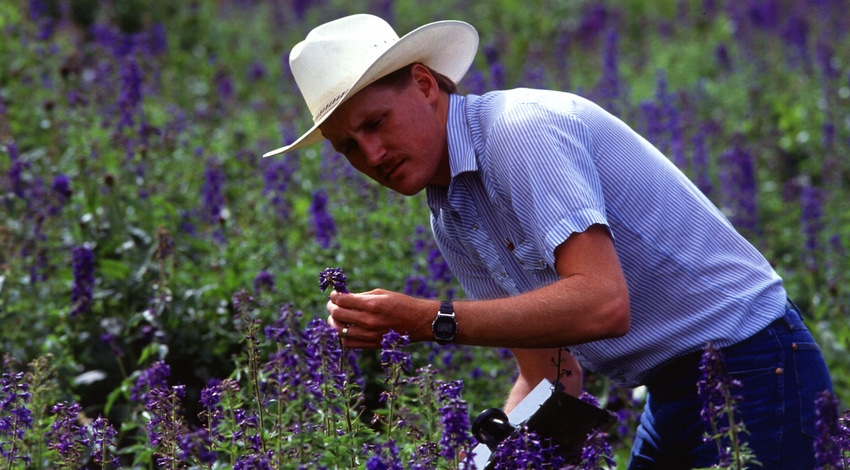April 7, 2022

Domestic cattle losses in the US due to toxic plants can number up to $50 million per year. Larkspur, a perennial native to the western US, is one of the plants that can be lethal to cattle.
Each population of larkspur differs in its toxicity. The forb’s concentration of alkaloids — nitrogen containing hydrocarbons — is affected by annual growing conditions.
Dan Cook, Plant Physiologist for the USDA Agriculture Research Service (ARS) Poisonous Plant Research Laboratory in Logan, Utah, says it’s a challenge to predict the toxicity level of larkspur for cattle. “It’s a complex environment for cattle,” he notes. “The bioactive compounds influence toxicity depending on concentration and compositions of alkaloids.”
The density and size of plants in an area also factors into toxicity.
“There are two varieties of larkspur: tall and low,” explains Ben Green, Pharmacologist at the USDA-ARS lab. “There is less of a toxicity problem with the low species. With the smallness of plants, cattle have to eat a lot of them to ingest a lethal dose.”
Through their USDA research on toxic plants, Green and Cook had recorded anecdotal data of cattle able to consume large quantities of larkspur without ill effects. They are now two years into a study to verify why. The researchers feed two pounds of powdered larkspur plant material daily to cattle that weigh about 1,000 pounds. The researchers phenotype the cattle by exercising them after dosage and recording time to clinical sign.
Quantifying larkspur tolerance
Green and Cook began their research with three cattle breeds: Angus, Hereford and Holstein. Two generations of these cattle were phenotyped for larkspur tolerance. “The Angus breed appeared to be more resistant,” Green explains. “It took them longer to show clinical signs of illness due to larkspur when compared to Herefords. Holsteins were the most resistant. The data pointed to an underlying genetic mechanism to why some animals were more resistant than others. It supported further research into heritable traits.”
With the Herefords appearing more susceptible to larkspur poisoning and Holstein’s low genetic diversity, Angus cattle were selected for the next research phase. To learn if larkspur tolerance could be passed from mother to offspring, the researchers selected Angus cattle that were either resistant or susceptible. With the identified heifers and bulls, the researchers paired the breeding for either extreme. Resistant bulls bred resistant heifers, and susceptible bulls bred susceptible heifers. The researchers followed this from F1 to F2 generation.
“The expectation was that, if larkspur resistance is a heritable trait,” Green says, “the offspring of a resistant breeding pair would also be resistant. What we found is that the offspring reverted to the average mean, for both resistant and susceptible breeding pairs. If larkspur resistance is inheritable, we’ve missed how to evaluate for the trait.”
Sheep and goats are quite resistant to larkspur due to their receptors that bind alkaloids to nicotine ACEtylcholine when they metabolize the plant. “We often use mice as a model for cows,” Cook explains. “We found that different strains of mice retain varying susceptibility to larkspur poisoning, which we traced to receptor structure. That’s why we went down the genetic path in cattle.”
Quality nutrition
Research in dosing cattle with larkspur did suggest that quality mineral nutrition helps them tolerate its toxicity. “Think of COVID,” Cook says, “the immunocompromised people are the most susceptible. If a cow doesn't have good mineral nutrition, she won’t tolerate attacks on her system.”
The study also showed larkspur toxicity is sex and age dependent. Yearling Angus heifers had a 330% greater relative risk than yearling Angus bulls for toxicity. As cattle age, both genders build resistance. “This informs management decisions,” Green says, “replacement heifers, which are young and female, should not be grazed in areas of larkspur.”
Green and Cook continue to research toxic plants. A study, with an artificial rumen, looks at how alkaloids are processed to see if digestion can be manipulated to lessen plant toxicity. They also explore how testing earwax samples can show if an animal died from consuming toxic plants, and by which plants. The researchers still pose questions, and follow data to answers, related to the heritability of larkspur tolerance.
“It may be related to gene expression and how cattle metabolize alkaloids,” Green says. “For instance, if a cow consumes larkspur while nursing, is her calf more resistant? There are more genetic options that may explain the differences. When our initial hypothesis was not correct, it raised more questions. That’s why we do research.”
About the Author(s)
You May Also Like




